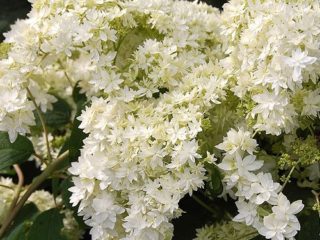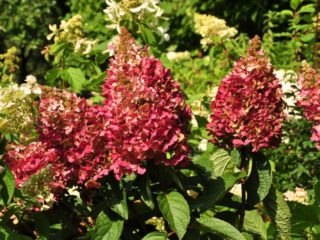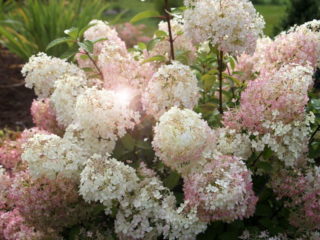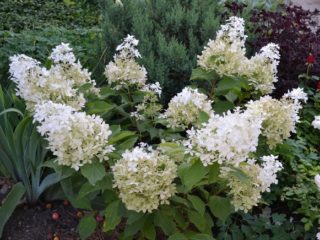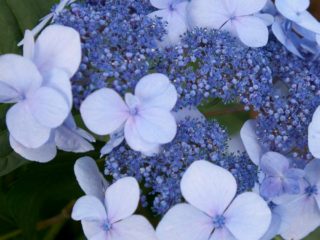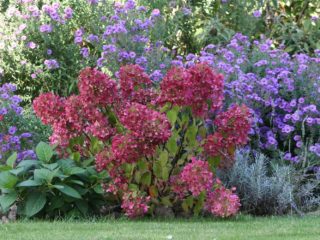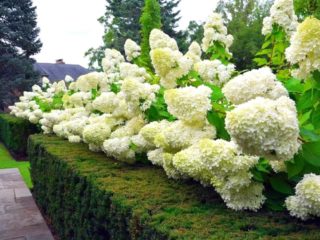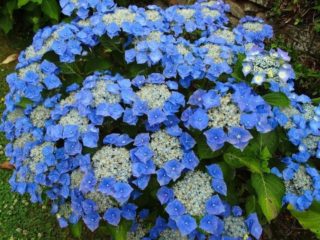Content
Often, with incorrect agricultural practices, many plants begin to hurt and wither. Hydrangea leaves turn yellow - a sure sign of lack of care or nutrition. The faster restoration operations are performed, the greater the chances of returning the bush to a healthy appearance.
Why do hydrangeas have yellow leaves?
Every housewife wants her indoor and ornamental plants to be healthy and delight them with abundant flowering. Hydrangea is grown not only in garden plots, but also at home. The appearance of yellow leaves in different growing conditions can be caused by several reasons.
For the proper development of any ornamental shrub, water and sunlight are necessary.Despite the fact that hydrangea is a fairly unpretentious plant from the point of view of watering, with incorrect agricultural practices you can seriously damage the health of the plant. It does not tolerate excessive waterlogging very well - excessive watering spoils the root system of the shrub.
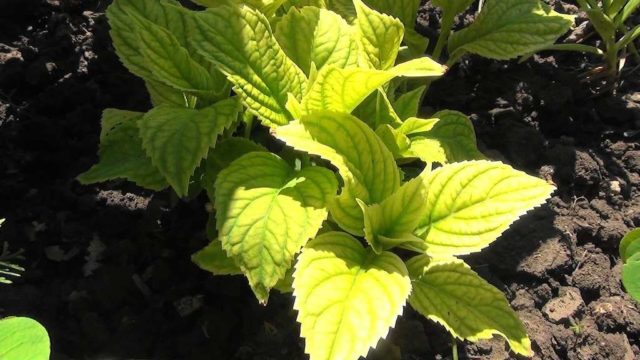
If the leaves begin to turn yellow, it is necessary to determine the cause as quickly as possible.
Hydrangeas also need to create special conditions in terms of lighting. Prolonged exposure to direct sunlight leads to leaf burns and further wilting. It is best to plant the shrub in partial shade or between large fruit trees.
Why do indoor hydrangea leaves turn yellow?
Many ornamental shrubs take root well at home. By creating ideal conditions for them, you can enjoy bright leaves and lush flowering throughout the year. But there are often cases when hydrangea suddenly begins to change the color of its leaves to yellow and brown. Most often, the causes of this disease are the following factors:
- Lack or excess of moisture. It is necessary to water the plant only after the top layer of soil has completely dried out.
- Insufficient humidity in the room. It is recommended to additionally spray the leaves or install a special climate control device.
- Low amount of nutrients. Hydrangea requires periodic fertilization - once every 7-10 days.
Don't forget about sunburn. Most often they happen when placing the pot on a windowsill in the southern part of the house or apartment. It is best to place the plant on the western or eastern side of the home - this will ensure moderate sunlight.
Why do garden hydrangea leaves turn yellow?
Unlike a house plant, placing a shrub on a site requires the gardener to follow clear conditions for caring for it. It is necessary to prepare a place for planting in advance - it should not be too open, but not too shaded. It is necessary to adhere to the watering schedule for applying fertilizers.
Despite strict adherence to agricultural technology, many gardeners are faced with the fact that the leaves gradually begin to turn yellow. This can be caused by a huge number of factors - from excess moisture to damage by insects and other pests. If the first signs of the disease are detected, it is important to begin measures to resuscitate the bush as soon as possible.
Causes of yellow leaves in hydrangea
As soon as the plant shows the first signs of wilting, it is necessary to pay attention to a large number of factors that could be the cause. If the leaves of paniculata hydrangea turn yellow not because of humidity and excess sunlight, the first thing to do is study the planting site. Hydrangea prefers acidic soils - a high alkali content can cause the shoots to dry out.
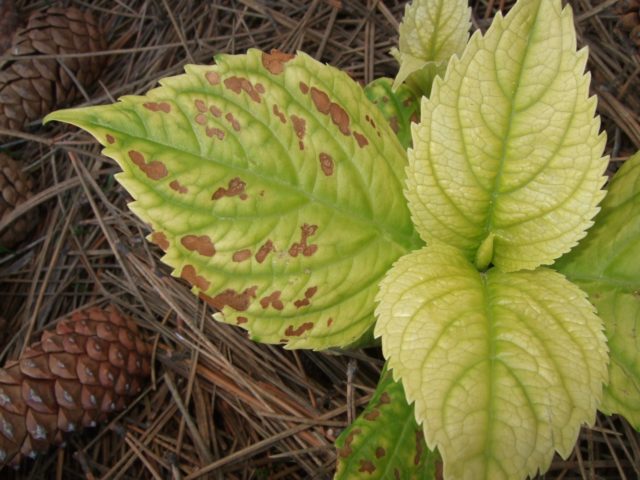
The most common cause of yellow leaves is non-compliance with the watering regime.
It is also important to pay attention to the ventilation of the landing site. The bush is quite sensitive to strong winds. Under unfavorable conditions, the leaves lose moisture, begin to turn yellow and dry out. In this case, it is recommended to either cover the hydrangea with special protective screens, or transplant it to a quieter place on the site.
Wrong choice of seedling
Modern nurseries abound with a huge number of ornamental plants of all shapes and colors. This is also facilitated by the rapid development of selection - every year several new varieties of flowers and shrubs appear. However, it is worth remembering that not every type of hydrangea can be cultivated under its original conditions.
Most often, when choosing seedlings, inexperienced gardeners give preference to varieties with the longest and most luxuriant flowering. For example, the leaves of large-leaved hydrangea almost immediately turn yellow during spring frosts. Despite the fact that even nurseries in the northern regions sell these types of hydrangeas, over time the bushes will begin to turn yellow due to the wrong climate. It is better to choose a variety that is resistant to sudden temperature changes and intended for cultivation in a specific climate zone.
Improper care
In addition to strictly following the schedule of watering and feeding, the shrub also needs additional manipulations to maintain a healthy appearance. Often the leaves of hydrangea paniculata begin to turn yellow due to insufficient oxygen flow to the roots already in August and September. To avoid withering of the shoots, it is necessary to dig up the trunk circles several times a year.
To prevent the leaves from turning yellow, it is important not to neglect pruning the bush. If all shoots lack nutrients, periodic thinning of the branches is necessary. It is carried out after the snow has melted before the active circulation of sap inside the trunk begins.
Adverse weather conditions
Even with full compliance with the rules for caring for tree or paniculate hydrangea, the leaves may begin to turn yellow due to the vagaries of nature. Prolonged rains or prolonged droughts negatively affect the health of most plants. Excessive waterlogging damages the root system of hydrangea, and the sun dries out the shoots.
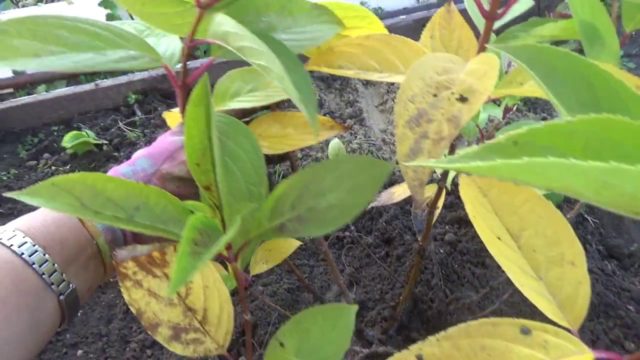
Shoots may turn yellow due to sudden frost
Sudden changes in air temperature can also cause sudden wilting of a plant. Night frosts in late spring or early summer harm fragile shoots. This is often the reason that entire branches turn yellow and gradually die.
Diseases and pests
One of the most common reasons that hydrangea leaves begin to turn yellow is that it is damaged by various viruses or microorganisms. Like most other ornamental plants, it has typical diseases that can lead not only to wilting, but also to the complete death of the bush.
Such ailments include:
- chlorosis;
- powdery mildew;
- white rot.
Pests include leaf aphids and spider mites. There are also frequent cases of hydrangea being damaged by garden slugs and root-knot nematodes. When parasites appear on a healthy plant, it is necessary to carry out a set of measures to destroy them as quickly as possible.
What to do if hydrangea has yellow leaves
As soon as the shoots on the bush begin to wither, it is necessary to quickly determine the cause of this and begin to take active action. It is important to remember that the sooner measures are taken, the greater the chance of maintaining the health of the hydrangea.
If the leaves turn yellow, then the following approaches are used:
- if there is a lack of moisture, increase the frequency of watering;
- if there is excess liquid, stop adding water for a while;
- for diseases - treatment with special chemicals;
- if the soil acidity is insufficient, apply special fertilizers;
- if pests are detected, use insecticides.
If the leaves begin to turn yellow due to damage to the roots caused by improper agricultural practices, the hydrangea must be replanted. In this case, damaged areas of the root system are removed. In the planting pits, the drainage layer is increased and additional acidic fertilizers are added.
How to feed hydrangea when the leaves turn yellow
Regular fertilization helps maintain a healthy appearance and ensure abundant flowering. If the leaves suddenly turn yellow, unscheduled feeding is necessary to restore health and strength after illness.
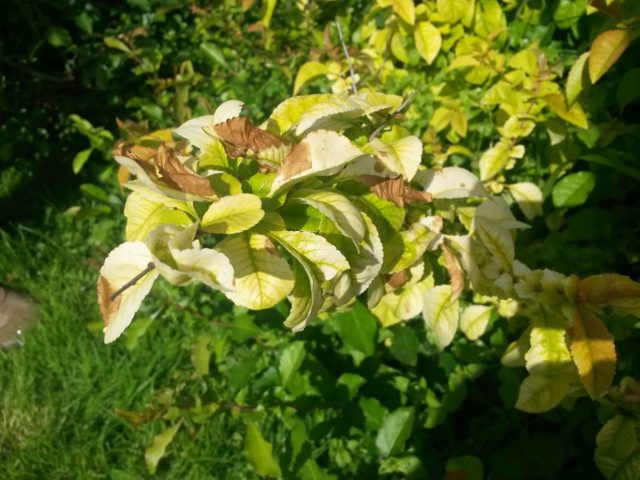
If the leaves turn yellow, it is necessary to apply nitrogen fertilizers.
The most important fertilizer for hydrangea is urea. It contains a large amount of nitrogen, which is necessary for the rapid transfer of nutrients from roots to leaves. 10-20 g of urea are mixed with 10 liters of water and applied under each bush.
In addition to urea, experienced gardeners recommend ammonium nitrate, chicken manure or cow manure. If the leaves have turned yellow, such bait will help stop the whole plant from wilting.
Advice from experienced gardeners
If a hydrangea leaf turns yellow, it must be removed. No method will return the green color to the shoot.All technologies are aimed only at stopping the disease. If an entire shoot dies, it is better to cut it off completely to avoid spreading the damage.
Often, hydrangea leaves begin to turn yellow when the bush is watered with the wrong water. Hard tap water with a large amount of impurities negatively affects the root system of a young plant. It is best to boil it and cool to room temperature before watering.
Since the shrub prefers acidic soils, you can feed it with natural additives. Add a few drops of lemon juice to 1 liter of water. It can be replaced with vinegar essence - in this case it is added at the rate of 1 tsp. for 10 liters of water.
Conclusion
Hydrangea leaves turn yellow - a sign of improper agricultural practices. Most often, this disease is caused by non-compliance with watering or care technology. As soon as the first signs of wilting are detected, it is necessary to take a set of measures as quickly as possible to restore the health of the plant.
